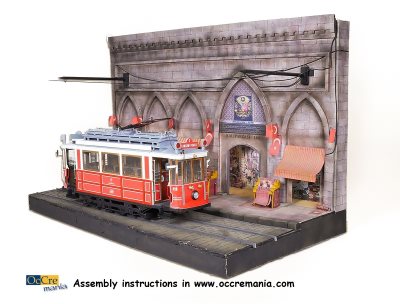Occre Istanbul Diorama for Istanbul Tram
£71.99 each
The diorama is a representation of the entrance to the Grand Bazaar of Istanbul, one of the largest in the world.
Located inside the old walled city, on the European side of Istanbul, between Nuruosmaniye, Mercan and Beyazit, with more than 58 covered streets and 4,000 shops or stalls, every day the bazaar attracts between 250,000 and 400,000 visitors.
The bazaar offers a wide range of products, in particular jewellers, precious metal workers, spice shops and carpet shops. The stalls tend to be grouped together by type, following the tradition of the ancient guilds. The bazaar includes two Bedestens, or domed stone-built structures, which are used for the storage of merchandise. The first of these was built in 1464, by order of Mehmet II, although it then had to be mostly rebuilt in 1864, following the earthquake.
The pack doesn't include Istanbul tram kit. It can be purchased separately in our website.
OcCre is quality modelling.
At OcCre we design each of our models with the same illusion that you have when assembling and making up the model. We take care of every last detail, so that our kit models can offer a design that is true to life. We manufacture using quality materials and ensure that every cut is made with precision. This makes the results of the assembly perfect. We use a range of different materials to make sure our models are more realistic. We guarantee that our model kits you will enjoy your enthusiasm for naval modelling, railway modelling, the modelling of trams and the modelling of vintage vehicles.
The diorama is a representation of the entrance to the Grand Bazaar of Istanbul, one of the largest in the world.
Located inside the old “walled city", on the European side of Istanbul, between Nuruosmaniye, Mercan and Beyazit, with more than 58 covered streets and 4,000 shops or stalls, every day the bazaar attracts between 250,000 and 400,000 visitors.
The bazaar offers a wide range of products, in particular jewellers, precious metal workers, spice shops and carpet shops. The stalls tend to be grouped together by type, following the tradition of the ancient guilds. The bazaar includes two Bedestens, or domed stone-built structures, which are used for the storage of merchandise. The first of these was built in 1464, by order of Mehmet II, although it then had to be mostly rebuilt in 1864, following the earthquake.
This fabulous diorama combines perfectly with the tram of Istanbul, joining the nostalgic line of Taksim-Tunnel with the Grand Bazaar, in an effort to group two large emblems of the city of Istanbul.
